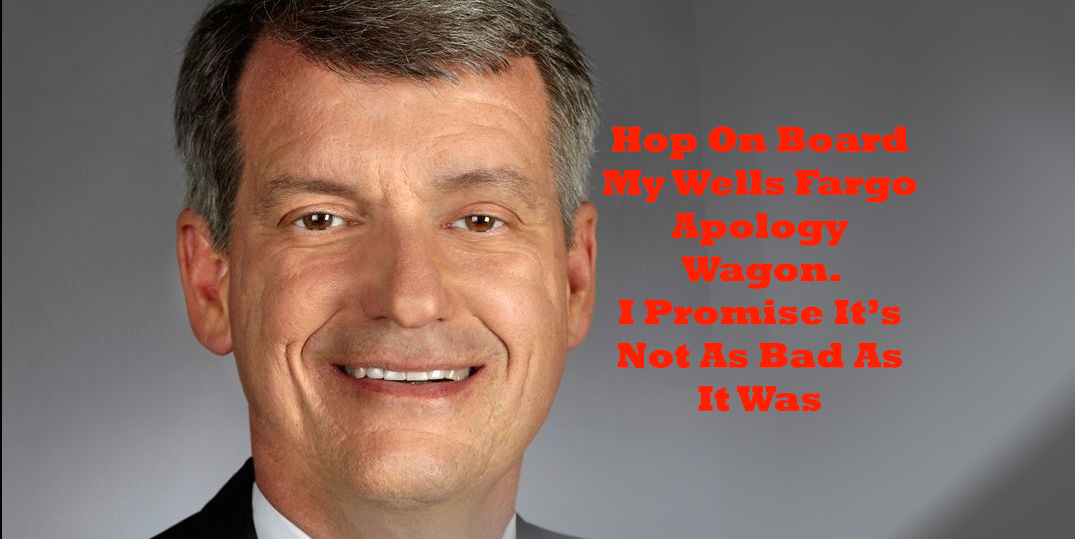
Wells Fargo CEO “Deeply Sorry” About That Time His Employees Opened Millions Of Fake Accounts In Customers’ Names
Tuesday morning, Wells Fargo CEO Tim “Apology Machine” Sloan will appear before the Senate Banking Committee to take some public tongue lashings for his bank’s fake account fiasco, which saw Wells employee opening up millions of bogus accounts in customers’ names in order to game the bank’s sales quota system. Sloan’s prepared remarks for this televised tomato-throwing include all manner of statements about how badly the bank behaved and how it’s darn-tootin’ not gonna let that happen again, but also don’t discuss one issue that will certainly be a hot-button topic among some senators in the room.
“I am deeply sorry for letting down our customers and team members,” writes Sloan in remarks [PDF] that will be given at a hearing with the TV-movie title of Wells Fargo: One Year Later. “I apologize for the damage done to all the people who work and bank at this important American institution. When the challenges at Wells Fargo demanded decisive action, the bank’s leaders acted too slowly and too incrementally. That was unacceptable.”
Before you congratulate Sloan for donning his bespoke hairshirt, remember that he wasn’t the CEO when some Wells employees were allegedly running roughshod over every ethical and moral guideline in the banking book, opening and closing various types of accounts just so it looked they were really good at selling people on financial products. Rather, John “Yeah, I do look like Jimmy Johnson’s evil banker brother” Stumpf, was the one who had to first explain to Congress why he repeatedly ignored customer complaints and corporate whistleblowers.
In fact, at the 2016 hearings on this scandal, Ol’ Stumpfy admitted that he’d heard about this sort of bad behavior in 2013, but did nothing to change the underlying problem until after the bank had been sued, after the media had reported on potential widespread abuse, and after the Consumer Financial Protection Bureau and others officially took action against Wells Fargo.
“When my predecessor testified here last year, we had not fully grappled with the damage the sales practices scandal had done to our customers, our team members, and their trust in the bank,” explains Sloan, dutifully tossing Stumpf to the wolves. “We came to Congress without a good plan and all of you were right to criticize us. But I heard you—and I heard our customers and our team members—loud and clear. You expect us to do better, and so do we.”
Of course, Sloan is not without blame. As individual reports of malfeasance began to percolate in the years leading up to the revelation of the fake account fiasco, the then-COO of Wells Fargo made statements denying claims of an “overbearing sales culture” at Wells Fargo.
The CEO’s remarks talk up, in incredibly dull detail, all the ways in which he claims that Wells Fargo is a “better bank today than it was a year ago. And next year, Wells Fargo will be a better bank than it is today.”
Or maybe you shouldn’t have been a horrible bank in the first place? Just a thought.
One thing that Sloan doesn’t address in his remarks, but which will surely be raised by Sen. Elizabeth Warren and possibly others is the issue of forced arbitration.
In spite of all his apologies and promises that Wells is now a better place to put your money than leaving it in a clear bag on a busy sidewalk, Sloan says nothing about his bank’s attempts to force customer lawsuits out of the court system and into individual, confidential arbitration.
When we pressed Wells Fargo on this issue last year, it continued to insist that arbitration is faster and more efficient than a lawsuit.
As we pointed out, that may be true when you’re talking about a single customer trying to resolve a very particular dispute (though we also know of individual arbitrations that have lagged on for years). Arbitration is far from the most effective way to figure out how to deal with a lawsuit where they may be more than 2 million plaintiffs. Surely it’s more efficient to hear one case instead of arbitrating 2 million individual cases?
There is also the question of whether or not Wells will get asked the questions that should be asked, as some members of the Senate Banking Committee have received not-insubstantial support from Wells in recent years.
For example, Sen. Pat Toomey (PA) received $42,400 from Wells Fargo during the 2016 election cycle. Committee Chair Sen. Mike Crapo (ID) received $27,000 from the bank in 2016. In all, Wells provided a total of nearly $200,000 to members of the Senate Banking Committee, with nearly $145,000 going to GOP committee members and a little more than $54,000 to Democrats.
When Stumpf appeared before the heavily bank-backed House Financial Services Committee in 2016, lawmakers who had received large amounts of funding from Wells Fargo attempted to divert the conversation away from the bank’s failures and toward the Consumer Financial Protection Bureau, which these committee members attempted to blame for Wells Fargo’s systemic failure to get employees to comply with the law.
[Updated to more accurately reflect the total amount of money contribued by Wells Fargo to members of the Banking Committee in 2016.]
Want more consumer news? Visit our parent organization, Consumer Reports, for the latest on scams, recalls, and other consumer issues.

